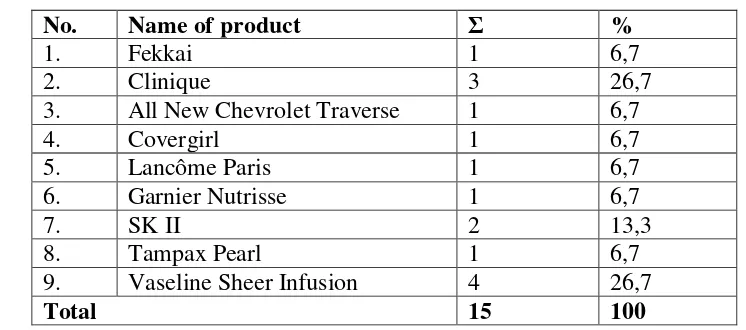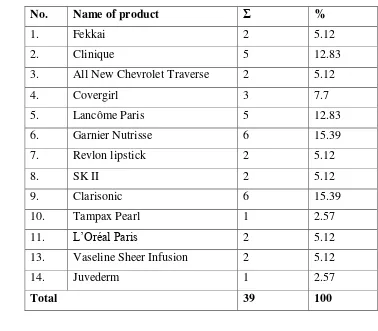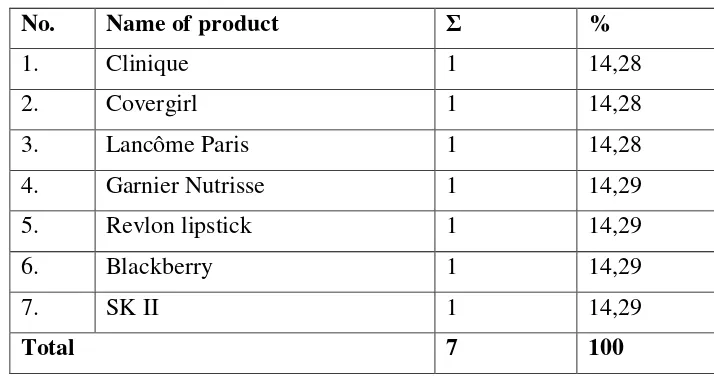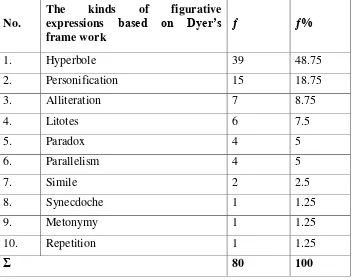1
AN ANALYSIS OF THE FIGURATIVE EXPRESSIONS AND
THE MEANINGS USED IN ADVERTISEMENTS
IN INSTYLE MAGAZINE
JOURNAL ARTICLE
Submitted in Partial Fulfillment of the Requirements for the Degree of Sarjana Sastra (S.S)
in English Language
By:
AZIZAH ISTIQOMAH SUNARDI
ENGLISH DEPARTMENT, FACULTY OF HUMANITIES
DIAN NUSWANTORO UNIVERSITY SEMARANG
1
AN ANALYSIS OF THE FIGURATIVE EXPRESSIONS AND THE MEANINGS USED IN ADVERTISEMENTS
IN INSTYLE MAGAZINE
Azizah Istiqomah, Sunardi
English Department Dian Nuswantoro University
ABSTRACT
Advertisement is paid non-personal communication from an identified sponsor using mass media to persuade and influence an audience. There are two kinds of the advertisements, broadcast advertisement (radio or television broadcast) and printed advertisement (newspaper, magazine, pamphlet, books and brochure). In this studies using magazine’s media to find the types of figurative expressions and the meanings used in the advertisements.. The analysis focused on stylistic and pragmatics because figure of speech is the part of the stylistic and the figurative meaning of figure of speech is the part of pragmatics. The types of figurative expressions were analyzed from the types of sentences written by the advertisers, while the meanings used by were analyzed through the advertisement language used in the magazine. The results of this study show that hyperbole is the most dominant in the advertisements, because it is used to persuade the customer to buy the products. The writer also found more connotative meaning than denotative meaning in advertisements. Advertisers used figure of speech to make advertisements interesting and persuading.
Keywords: Advertisement, Figurative Expressions, Magazine, Purposes, Products.
Periklanan adalah komunikasi yang bukan perorangan dari sponsor yang dikenal dengan menggunakan media massa untuk meyakinkan dan mempengaruhi pembeli. Ada dua macam periklanan, siaran periklanan (radio/siaran televisi) dan periklanan yang berwujud tulisan (koran, majalah, pamplet, buku-buku dan brosur). Dalam penelitian ini menggunakan media majalah untuk menemukan tipe-tipe ekspresi figuratif dan penggunaan makna di dalam periklanan. Analisa ini fokus pada ilmu gaya bahasa dan pragmatis karena kata kiasan adalah bagian dari ilmu gaya bahasa dan makna figuratif dari kata kiasan adalah bagian dari pragmatis. Tipe-tipe ekspresi figuratif diteliti dari kalimat-kalimat yg ditulis oleh pengiklan, sedangkan penggunaan makna diteliti melalui bahasa iklan yang digunakan di dalam majalah. Hasil penelitian ini menunjukkan bahwa penggunaan bahasa hiperbola paling banyak digunakan di dalam iklan, karena hal itu digunakan untuk meyakinkan pelanggan untuk membeli barang. Penulis juga menemukan lebih makna konotatif daripada makna denotatif di dalam iklan. Pengiklan menggunakan kata kiasan untuk membuat periklanan memikat dan meyakinkan .
2 INTRODUCTION
Language is one of communication tools which is used directly. It can be in written or spoken form. It is also related to communication devices such as television, radio, newspaper, magazines, internet or the other media. Language is used to give information and persuade the other people. Because of that reason, language is implemented in advertisement.
Language used in advertisement must be easy to understand, catchy and persuasive, because advertisement itself have to persuade the customer to buy and use the product. Moreover, according to Amstel (1969:11) states that advertisement also can be used to support a distribution of products, because it provides important information for the customer.
Liliweri (1992: 42-43) states that publisher media is used based on the advertisement target of the audience (e.g. consumer and industrial), geography (e.g. local and international), medium used by advertiser (e.g. broadcast or printed) and by its purpose or function (e.g. product advertising, noncommercial advertising, direct action advertising, and etc).
Magazine also shows attractive picture and illustration, so it can support the language. The readers will see the pictures of the products that being offered by advertiser and read the language of the advertisement. In order to make the advertisement interesting, the advertiser must use persuasive language because it is aimed to persuade consumer. As the result, the readers can remember and interest to the product. In the end of the day, they will buy the products.
To achieve the purpose, Wells (1997:11) said, “The language of advertisement should be simple, well-arranged, effective, and communicative, so that the advertisements are easy to be understood.” Usually, the language of advertisement is daily language. It is chosen because this advertisement will be closer to the readers or audiences. On the other hand, sometimes it uses the figure of speech. It is used to attract and get attention from the people who watch, read or listen to the advertisement.
According to Furniss (1996:106), we know that word, phrase or statement is figurative, when it cannot be taken literary. In other words, there are figurative words or phrases that cannot be literary true in circumstances. So, when the word or phrase cannot be literary true, people will automatically understand it in a figurative sense. Hence, figure of speech is closely related to figurative meaning. It proves that figure of speech which produces figurative meaning, is linguistically used in analyzing word, phrase, or clause.
One of example of advertisement which uses figurative language is: Fekkai Advance Brilliant Glossing.
There is a testimonial from Frederic Fekkai (InStyle, 2010:2), It’s your most powerful accessory. It can be concluded that this statement uses hyperbole to convince the costumer that the product used for the accessory to the beauty of customer look. Besides, it will make extravagant statement used to make strong point, but not intended to be taken literally.
3
and provide an understanding on the figurative meaning of the figures of speech used in the advertisement in InStyle magazine.
METHOD
Research Design
The research design is stage process which is needed in planning and doing a research. The study is a pragmatic analysis by using stylistic approach as suggested by Gillian Dyer (1982). This study was conducted by analysing clauses under study from two linguistics knowledges: the pragmatics knowledge and the stylistics knowledge. The pragmatics knowledge were proved by studying the types of figurative meaning of the figures of speech, although the stylistics knowledge were searched from the figures of speech.
Data
The corpus of data of this study was taken from a kind of printed advertisement: it was a magazine. Based on purposive sample the researcher takes fifteen out of fifty three advertisements. The data were analyzed from the tag line, sub head, and the body text of the advertisements. The subject here was an InStyle magazine edition January, 2010.
Unit of Analysis
This study focused on clause. The researcher analyzed the figures of speech and the figurative meaning that can be found in the clause. Every clause will be analyze based on Dyer„s framework (1982:152).
Data Collection
The data of this research was collected from international network. The researcher uses the method of library research to get more information about this research especially in sociolinguistics register. The data were classified based on the unit of analysis and Dyer„s framework (1982:152).
FINDINGS AND DISCUSSION
The analysis of the types of figurative expressions and the meanings used in the advertisements can be seen in the table below:
The kinds of figurative expressions based on Dyer’s frame work
Table 1. The frequency of Metonymy in InStyle Magazine edition January, 2010
No. Name of product Σ %
1. Tampax Pearl 1 100
4
Table 2. The frequency of Personification in InStyle Magazine edition January, 2010
No. Name of product Σ %
1. Fekkai 1 6,7
2. Clinique 3 26,7
3. All New Chevrolet Traverse 1 6,7
4. Covergirl 1 6,7
5. Lancôme Paris 1 6,7
6. Garnier Nutrisse 1 6,7
7. SK II 2 13,3
8. Tampax Pearl 1 6,7
9. Vaseline Sheer Infusion 4 26,7
Total 15 100
Table 3. The frequency of Simile in InStyle Magazine edition January, 2010
No. Name of product Σ %
1. L‟Oreal Paris 1 50
2. Juvederm 1 50
Total 2 100
Table 4. The frequency of Synecdoche in InStyle Magazine edition January, 2010
No. Name of product Σ %
1. Juvederm 1 100
Total 1 100
Table 5. The frequency of Litotes in InStyle Magazine edition January, 2010
No. Name of product Σ %
1. Clinique 1 12,5
2. All New Chevrolet Traverse 2 25
3. Lancôme Paris 2 25
4. Garnier Nutrisse 1 12,5
5. Blackberry 1 12,5
6. Hershey‟s Special Dark 1 12,5
5
Table 6. The frequency of Paradox in InStyle Magazine edition January, 2010
No. Name of product Σ %
1. Blackberry 2 50
2. Juvederm 2 50
Total 4 100
Table 7. The frequency of Hyperbole in InStyle Magazine edition January, 2010
No. Name of product Σ %
1. Fekkai 2 5.12
2. Clinique 5 12.83
3. All New Chevrolet Traverse 2 5.12
4. Covergirl 3 7.7
5. Lancôme Paris 5 12.83
6. Garnier Nutrisse 6 15.39
7. Revlon lipstick 2 5.12
8. SK II 2 5.12
9. Clarisonic 6 15.39
10. Tampax Pearl 1 2.57
11. L‟Oréal Paris 2 5.12
13. Vaseline Sheer Infusion 2 5.12
14. Juvederm 1 2.57
Total 39 100
Table 8. The frequency of Parallelism in InStyle Magazine edition January, 2010
No. Name of product Σ %
1. Covergirl 1 25
2. Lancôme Paris 1 25
3. Garnier Nutrisse 1 25
4. Revlon lipstick 1 25
6
Table 9. The frequency of Alliteration in InStyle Magazine edition January, 2010
No. Name of product Σ %
1. Clinique 1 14,28
2. Covergirl 1 14,28
3. Lancôme Paris 1 14,28
4. Garnier Nutrisse 1 14,29
5. Revlon lipstick 1 14,29
6. Blackberry 1 14,29
7. SK II 1 14,29
Total 7 100
Table 10. The frequency of Repetition in InStyle Magazine edition January, 2010
No. Name of product Σ %
1. Lancome Paris 1 100
7
Table 11. The Summary of the types of figurative expressions and the meanings used in the advertisements
Metonymy
Metonymy is figure of speech in which the name of an object or concept is replaced with a word closely related or suggested by the original, as crown for king. Metonymy has the effect of creating concrete and vivid images in place of generalities, as in the substitution of a specific grave for the abstraction death.
As shown in table 1 based on Dyer explanation that metonymy is substitutions of the name of thing for that of another with which is closely associated. “Mother Nature’s Monthly Gift” substitutes for “Woman period or menstruation”. So, this is categorized as metonymy.
Personification
Personification is the figure of speech in which human characteristic are attributed to an abstract quality, animal, or inanimate object. It gives animals, objects, ideas, human quality as if they can act and perform the actions like human beings.
Table 2, for example in Lancôme Paris. It can be found in the body of the advertisement. It can be seen in 7000 micro-vibrations per minutes break down
mineral powder for seamless blendability and perfect coverage (InStyle, 2010:14). From the excerpt above, it can be seen that the micro-vibration can do something like human being does. It can break down the mineral powder as the human break down something. Based on Dyer‟s frame work, it can be categorized as personification.
No.
The kinds of figurative expressions based on Dyer’s frame work
ƒ ƒ%
1. Hyperbole 39 48.75
2. Personification 15 18.75
3. Alliteration 7 8.75
4. Litotes 6 7.5
5. Paradox 4 5
6. Parallelism 4 5
7. Simile 2 2.5
8. Synecdoche 1 1.25
9. Metonymy 1 1.25
10. Repetition 1 1.25
8 Simile
It is a figure of speech whereby two concepts are imaginatively and descriptively compared. Shaw (1972:344) explained that the common heritage of similes in everyday speech usually reflects simple comparison based on the natural world or familiar domestic object. The words like and as are the comparison words which are commonly used.
The word “like” in table 3 of product L‟Oréal Your time to shine like a star (InStyle, 2010:77) is a connectivity which indicates simile. The simile shows something unknown can be understood because it is similar to something known. In this time, the advertiser compare the customer of L‟Oréal will shine as the Hollywood star. As the result, this clause can be categorized as simile.
Synecdoche
Synecdoche is taken from Greek means take up with something else. It is figure of speech in which a part represents the whole, as in the expression hired hands for workmen, or less commonly, the whole represents a part, as in the use of the word society to mean high society.
It can be seen from the using of part of face, mouth and nose in Juvederm in table 4. The advertiser uses replacement of a word by one closely related to the original. The use of synecdoche can simplify what is being talked about by stating significant detail only. So, it can be called as synecdoche.
Litotes
Litotes is a figure of speech, conscious understatement in which emphasis is achieved by negation. It often takes the form of a negative phrase or statement used to express the opposite; whether praising. For example in table 5, ...Not available with some other offers. (InStyle, 2010:9) it can be seen that the advertiser uses litotes. It is use to emphasize Chevrolet Traverse giving a special offer for buying Traverse. This phrase also makes the statement understandable for the reader. As the result, it is categorized as litotes.
Paradox
Paradox is apparently self-contradictory statement. The underlying meaning of which is revealed only by careful scrutiny. The purpose of paradox is to get attention and provoke fresh thought. There is a paradox in the Juvederm advertisement. It can be seen in table 6, parentheses have a place but not on your face. It is clear written ...have place but not on your face. There is contradiction that illogically joins in together between “have a place” and “not on your face”. From this short explanation, it can be categorized as paradox.
Hyperbole
9
product is smart and more than the reader. This statement is to exaggerate the reader with extravagant statement used to make strong point. So, this sentence is categorized as hyperbole.
Parallelism
Parallelism is the repetition of sounds, meanings, and structures serves to order, emphasizes, and point out relations. The simplest form of parallelism consists of single word that has a slight variation in meaning: „ordain and establish‟ or „overtake and surpass‟. In the table 8, in product Lancome Paris, Talc-free, oil-free, fragrance-free (InStyle, 2010:14) In this time the advertiser uses parallelism to emphasize the word “free”. It means that this product is a very good idea to make the skin disentangle from talc, oil, and pleasant. It can be concluded as parallelism.
Alliteration
Alliteration is the repetition of the initial consonant in two or more words. It is a deliberate phonological device. It is also mostly associated with literary, especially poetic, but it is also found in popular idioms (e.g. rack and ruin; as dead as a doornail), tongue twister (Peter Piper picked a peck of pickled pepper) and advertising language (Guinness is good for you).
For example in table 9 in Clinique, Fragrance Free (InStyle, 2010:4) In this time, the advertiser repeats the consonant “f”. It is used for making the reader remember that this product does not use any fragrance. It is more effective than uses litotes “no fragrance” because the repetition makes the similar sound or phoneme in the first both of the two words. So, it is categorized as alliteration.
Repetition
It refers to words that are repeated in the text, as well as words that have changed to reflect tense or number. Repetition, or sometimes called reiteration, is the most direct and obvious source of lexical cohesion since it is the mere identical recurrence of a preceding lexical item. Talc-free, oil-free, fragrance-free
(InStyle, 2010:14) This excerpt shows repetition. The advertiser uses free to repeat the word free which is placed in the previous. There is the referential link the signaling that the same free is intended. Repetition therefore establishes a cohesive tie between at least two identical lexical items.
CONCLUSION
10
Synochdoche, Metonymy and Repetition 1 data (1.25%). The rests are Metaphor, Anaphora, and Irony are not found in the advertisements.
Hyperbole is the most dominant in the advertisements, because it is used to persuade the customer to buy the products. The writer also found more connotative meaning than denotative meaning in advertisements. It proves that composers used figure of speech to make advertisements interesting and persuading.
BIBLIOGRAPHY
Amstell, J. I. 1969. Advertising. New York: Oceana Publications Inc.
Dyer, Gillian. 1982. Advertising as Communication. London: Routledge.
Furniss, C. 1996. An Introduction to Poetry. Boston: Little Brown and Company.
Liliweri, A. 1992. Dasar-dasar Komunikasi Periklanan. Bandung: PT. Citra Aditya Bhakti.
Nelson, Martha. InStyle Volume 17 Januari. 2010. New York: Time Inc.




